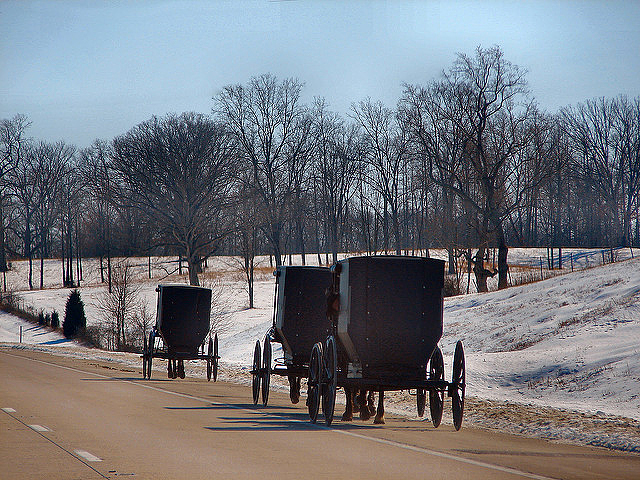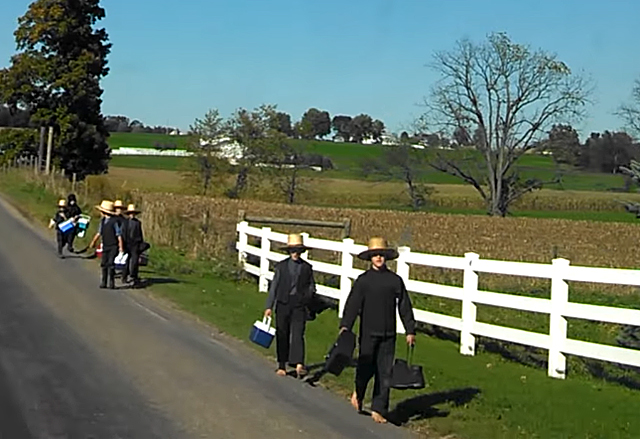Some Ohio Swartzentrubers, probably the most conservative of the Amish groups, have decided to make changes in their buggies to improve their safety on the public roads. The Akron Beacon Journal last week published an interesting report on how the Swartzentrubers (also sometimes spelled Schwartzentrubers) in three northeastern Ohio counties are trying to lessen the number of road accidents that involve them.

The rural areas of Ashland, Medina and Wayne counties where this group of Swartzentrubers live has been hard hit by crashes—more than 250 in the three counties since 2012. During the first three months of 2017, three people died and 17 more were injured from vehicle/buggy collisions on the roads in that part of Ohio. Until recently, the Swartzentrubers resisted making any changes that might help prevent the spate of accidents. They have relied on 72 inches of gray reflective tapes on the backs of their buggies, as required by state law, to warn approaching motorists—the orange tapes and slow-moving vehicle triangles used by other Amish groups are too flashy for them. They also hang kerosene lanterns on the sides of their buggies in hopes that they will increase their visibility.
But three Amish men, recognizing the growing accident rate, decided to see if their group would be willing to make some modest changes. Then, they agreed to be interviewed by a Beacon Journal reporter, Amanda Garrett, and they explained to her the changes they are making.

Harvey Stutzman, one of the three men, told Ms. Garrett, “The three words that best define us are probably modesty, simplicity and plain.” He and two colleagues, Levi Hostetler and Eli Hostetler, met early in 2017 after a crash had killed still another Amish person. They showed the reporter two safety additions they had decided to add to their buggies, improvements that they hope will help avoid future accidents.
Since the majority of vehicle/buggy collisions occur in the daytime, they reasoned, one of the problems might be that the black buggies sometimes visually disappear into the black surfaces of the roads, so motorists don’t see them. The solution adopted by the group has been to fabricate 10-inch by 12-inch rectangular pieces of white plastic, outlined with reflective tape, that the Amish can then attach to the backs of their buggies. While perhaps not so noticeable as the flashy safety triangles, they felt their community would accept and use them. And the bright white rectangles should, they hope, catch the attention of drivers approaching from the rear because of their contrast to the black.
A second innovation was to make short pieces of PVC pipe that would extend the buggy axles out a few inches farther from the wheels. These extensions would be covered with bright, reflective tapes that would catch the attention of motorists as they spin on a buggy moving ahead on a highway. They should be especially noticeable during nighttime driving.

The reporter asked one of the Ashland County Commissioners, Mike Welch, about the Swartzentruber solutions. He gave his support, expressing pleasure that they are willing to compromise their beliefs a bit to lessen the accident rate. An Ohio State Highway Patrol officer, Lt. Stephanie Norman, told the Beacon Journal that the Amish themselves approached safety officials soliciting suggestions that might lessen the number of accidents on the roads of Ohio Amish Country. She expressed approval for the compromising spirit of the Amish. Requiring them to put bright lights on their buggies would violate their beliefs.
The three Swartzentruber men are also encouraging the other Amish to use larger kerosene lanterns on the sides of their buggies. They feel that the chimneys of smaller lanterns can become clouded from the smoke off the burning wicks and darken the surface of the glass, obscuring the visibility of the lights for approaching motorists. The taller lanterns do not seem to have that problem as much.
Captain Doug Hunter, Sheriff of Wayne County, said he also met with the Amish leaders. He explained that they have always complied with state laws by putting the required six feet of reflecting tape on their buggies. But the white rectangles and the PVC pipe axle extenders exceed state law, which is good, he felt.

Part of the motivation for the three Amish men, with whom Ms. Garrett met in April, has also been to help protect the spirits of the motorists who drive their vehicles and collide with the buggies. They are aware of the guilt such drivers would probably carry with them for the rest of their lives if they hit Amish people along a country road and killed someone. But Levi Hostetler also couldn’t help wondering why motor vehicle drivers were always in such a hurry in their cars and trucks. “It’s like they all left for work 15 minutes late,” he said. He did not really suggest a solution to that problem.